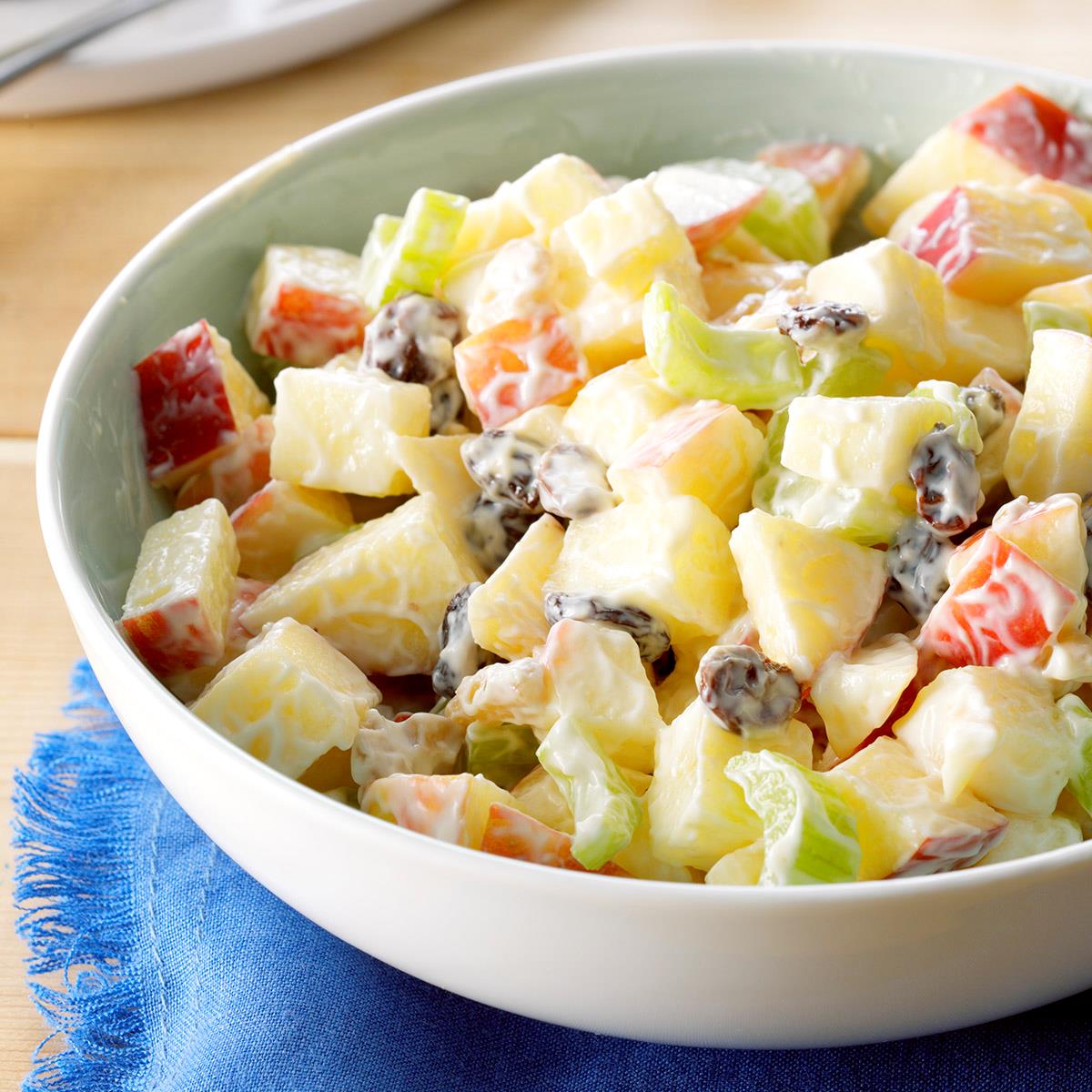Waldorf salad, a beloved culinary creation, has graced tables for over a century, captivating taste buds with its delightful blend of crisp apples, crunchy celery, and toasted walnuts. Originating in the heart of New York City’s Waldorf Astoria Hotel, this iconic dish has undergone a culinary evolution, inspiring countless variations while remaining a timeless favorite.
In this comprehensive guide, we will delve into the secrets of crafting a perfect Waldorf salad. From the traditional ingredients to modern interpretations, we will explore the nuances of this classic recipe. We will also uncover its nutritional value, cultural significance, and provide creative serving suggestions to elevate your culinary experience.
Waldorf Salad Ingredients
The traditional Waldorf salad, a classic American dish, is a simple yet flavorful combination of crisp apples, crunchy celery, and toasted walnuts, bound together with a creamy mayonnaise dressing. However, modern interpretations have introduced variations and additions to the classic recipe, expanding its versatility and appeal.
Traditional Ingredients
- Apples: Crisp and tart apples, such as Granny Smith or Pink Lady, provide a refreshing contrast to the other ingredients.
- Celery: Crunchy celery adds texture and a subtle celery flavor.
- Walnuts: Toasted walnuts bring a nutty crunch and a hint of sweetness.
- Mayonnaise: A creamy mayonnaise dressing binds the ingredients together, adding richness and flavor.
- Lemon juice: A squeeze of lemon juice brightens the salad and balances the sweetness of the apples and walnuts.
Variations and Modern Interpretations
While the traditional ingredients remain the core of a Waldorf salad, modern variations have emerged, experimenting with different flavors and textures:
- Dried fruit: Dried cranberries, raisins, or cherries add a touch of sweetness and tartness.
- Fresh herbs: Chopped parsley, chives, or tarragon enhance the salad with freshness and aromatic flavors.
- Cheese: Grated cheddar, blue cheese, or goat cheese add a savory element and creamy texture.
- Vinegarette dressing: A light vinaigrette dressing can replace mayonnaise for a tangier and lighter alternative.
Step-by-Step s
Follow this step-by-step guide to create a delicious and refreshing Waldorf salad:
Preparation
- Chop the apples: Cut the apples into small, uniform cubes to ensure even distribution throughout the salad.
- Slice the celery: Thinly slice the celery to add a crunchy texture and freshness.
- Chop the walnuts: Coarsely chop the walnuts to provide a nutty flavor and a contrasting texture.
- Mix the dressing ingredients: In a separate bowl, whisk together the mayonnaise, lemon juice, sugar, and salt until well combined.
Assembly
- Combine the ingredients: In a large bowl, combine the chopped apples, celery, walnuts, and raisins.
- Add the dressing: Pour the prepared dressing over the salad and gently toss to coat all the ingredients evenly.
- Chill before serving: Refrigerate the salad for at least 30 minutes before serving to allow the flavors to blend and the dressing to set.
Tips for Achieving the Best Texture and Flavor
- Use a sharp knife to ensure clean cuts and uniform-sized ingredients.
- Do not overmix the salad, as this can break down the apples and make the salad mushy.
- If you prefer a sweeter salad, add more sugar to the dressing.
- For a tangier flavor, add more lemon juice to the dressing.
Variations and Adaptations
The Waldorf salad is a versatile dish that can be easily customized to suit different tastes and dietary needs. Here are some popular variations and adaptations:
Fruits
The addition of fruits to the Waldorf salad can enhance its sweetness and nutritional value. Common fruit additions include:
- Apples: Granny Smith or Pink Lady apples provide a tart and crisp contrast to the other ingredients.
- Grapes: Red or green grapes add a juicy sweetness and a pop of color.
- Berries: Blueberries, raspberries, or strawberries add a burst of flavor and antioxidants.
- Dried fruits: Cranberries, raisins, or cherries provide a chewy texture and a concentrated sweetness.
Nuts
Nuts can add crunch and a nutty flavor to the Waldorf salad. Some popular nut additions include:
- Walnuts: The classic choice for Waldorf salad, walnuts provide a rich and earthy flavor.
- Pecans: Pecans add a buttery sweetness and a slightly crunchy texture.
- Almonds: Sliced almonds provide a delicate crunch and a mild nutty flavor.
- Pistachios: Chopped pistachios add a vibrant green color and a slightly salty flavor.
Cheese
The addition of cheese to the Waldorf salad can add a creamy richness and a savory flavor. Some popular cheese additions include:
- Blue cheese: Crumbled blue cheese adds a sharp and tangy flavor.
- Feta cheese: Crumbled feta cheese adds a salty and tangy flavor.
- Goat cheese: Crumbled goat cheese adds a creamy and slightly tangy flavor.
- Parmesan cheese: Grated Parmesan cheese adds a nutty and salty flavor.
Dietary Adaptations
The Waldorf salad can also be adapted to suit different dietary restrictions or preferences. Here are some examples:
- Vegan: To make a vegan Waldorf salad, replace the mayonnaise with a vegan mayonnaise or a plant-based yogurt.
- Gluten-free: To make a gluten-free Waldorf salad, use gluten-free bread or crackers.
- Low-fat: To make a low-fat Waldorf salad, use low-fat mayonnaise or a non-fat yogurt.
- Low-carb: To make a low-carb Waldorf salad, replace the apples with celery or jicama.
Nutritional Value and Health Benefits
Waldorf salad is a nutritious dish packed with essential vitamins, minerals, and antioxidants. The combination of fruits, vegetables, and nuts provides a well-rounded nutritional profile.
Fruits and Vegetables
- Apples: Rich in fiber, vitamin C, and antioxidants.
- Celery: A good source of vitamin K, potassium, and fiber.
- Grapes: Provide antioxidants, vitamin C, and potassium.
Nuts and Seeds
- Walnuts: High in omega-3 fatty acids, protein, and fiber.
- Raisins: Contain antioxidants, potassium, and fiber.
Consuming these ingredients offers several health benefits:
- Improved heart health due to omega-3 fatty acids and fiber.
- Reduced risk of chronic diseases like cancer and heart disease due to antioxidants.
- Enhanced digestion due to fiber.
- Boosted immunity due to vitamin C.
- Reduced inflammation due to antioxidants.
History and Cultural Significance

The Waldorf salad was created in 1893 by Oscar Tschirky, the maître d’hôtel of the Waldorf-Astoria Hotel in New York City. The salad was originally made with apples, celery, walnuts, and mayonnaise. Over time, other ingredients have been added to the salad, such as grapes, raisins, and cheese.
The Waldorf salad has become a popular dish around the world and is often served at parties and gatherings.
The Waldorf salad is a symbol of American cuisine. It is a simple, yet elegant salad that is perfect for any occasion. The salad is also a reminder of the golden age of New York City, when the Waldorf-Astoria Hotel was one of the most luxurious hotels in the world.
Evolution Over Time
The Waldorf salad has evolved over time to reflect the changing tastes of diners. In the early 1900s, the salad was made with simple ingredients, such as apples, celery, walnuts, and mayonnaise. Over time, other ingredients were added to the salad, such as grapes, raisins, and cheese.
Today, there are many different variations of the Waldorf salad, each with its own unique flavor.
Serving Suggestions and Presentation Ideas
Waldorf salad is a versatile dish that can be enjoyed as an appetizer, side dish, or even a main course. As an appetizer, it offers a refreshing and flavorful start to a meal. As a side dish, it complements grilled meats, fish, or poultry.
It can also be served as a light main course for lunch or dinner, especially when paired with a hearty bread or soup.When it comes to presentation, Waldorf salad provides ample opportunities for creativity. The vibrant colors of the ingredients make it visually appealing, and you can enhance its presentation further with simple techniques.
For instance, you can arrange the ingredients in a decorative pattern on a serving platter or use a cookie cutter to shape the apples into stars or hearts. You can also serve the salad in individual ramekins or martini glasses for a more elegant touch.
Tips for Creative Presentation:
- Use a variety of colors and textures to create a visually appealing salad. Consider adding chopped walnuts, dried cranberries, or crumbled blue cheese for additional color and crunch.
- Arrange the salad ingredients in a decorative pattern on a serving platter. For example, you could create a wreath shape with the apples, celery, and grapes.
- Use a cookie cutter to shape the apples into stars or hearts. This is a fun way to add a festive touch to the salad.
- Serve the salad in individual ramekins or martini glasses. This will give the salad a more elegant look and make it easier for guests to serve themselves.
Waldorf Salad Dressing
A classic Waldorf salad dressing is made with a combination of mayonnaise, yogurt, lemon juice, Dijon mustard, sugar, salt, and black pepper. To make the dressing, simply whisk together all of the ingredients until smooth.
Variations and Alternatives
There are many variations and alternatives to the traditional Waldorf salad dressing. Some popular variations include:
- Using Greek yogurt instead of mayonnaise for a healthier option.
- Adding a touch of honey or maple syrup for sweetness.
- Adding a dash of cayenne pepper for a bit of spice.
- Using apple cider vinegar instead of lemon juice.
Final Summary

Whether you prefer the traditional Waldorf salad or enjoy experimenting with contemporary twists, this dish offers a symphony of flavors and textures that will delight your palate. Its versatility makes it an ideal appetizer, side dish, or even a light main course.
So, gather your ingredients, sharpen your knives, and let us embark on a culinary journey that will leave you craving for more.
Questions and Answers
Can I use other types of nuts in Waldorf salad?
Yes, while walnuts are traditional, you can substitute them with pecans, almonds, or hazelnuts for a unique flavor profile.
How do I make a vegan Waldorf salad?
To make a vegan Waldorf salad, replace the mayonnaise with a plant-based alternative such as vegan mayonnaise or hummus.
Can I add other fruits to my Waldorf salad?
Absolutely! Grapes, berries, or even pineapple can add a burst of sweetness and color to your salad.
How long can I store Waldorf salad in the refrigerator?
Waldorf salad can be stored in an airtight container in the refrigerator for up to 3 days. However, it is best enjoyed fresh.
